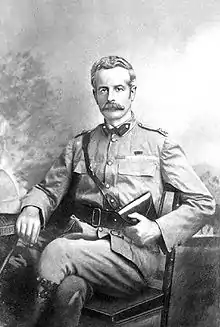Douglas Cochrane, 12th Earl of Dundonald
Lieutenant General Douglas Mackinnon Baillie Hamilton Cochrane, 12th Earl of Dundonald, KCB, KCVO (29 October 1852 – 12 April 1935), styled Lord Cochrane between 1860 and 1885, was a Scottish representative peer and a British Army general.
The Earl of Dundonald KCB, KCVO | |
|---|---|
 Lord Dundonald in 1904 | |
| Personal details | |
| Born | 29 October 1852 Banff, Scotland |
| Died | 12 April 1935 (aged 82) Wimbledon, England |
| Spouse(s) | |
| Relations | Thomas Cochrane, 1st Baron Cochrane of Cults (brother) |
| Children | 5, including Thomas |
| Parents | Thomas Cochrane, 11th Earl of Dundonald Louisa Harriet Mackinnon |
| Education | Eton College |
| Military service | |
| Allegiance | |
| Branch/service | |
| Rank | Lieutenant General |
| Commands | General Officer Commanding the Militia of Canada 2nd Regiment of Life Guards |
| Battles/wars | Mahdist War Second Boer War First World War |
| Awards | Mentioned in Despatches (7) |
Early life
Cochrane was the second but eldest surviving son of Thomas Cochrane, 11th Earl of Dundonald, by Louisa Harriet Mackinnon, daughter of William Alexander Mackinnon. Thomas Cochrane, 1st Baron Cochrane of Cults, was his younger brother.[1] He was educated at Eton College.[2]
Military career
Cochrane was commissioned into the Life Guards in July 1870,[3] and was promoted to lieutenant the following year and captain in 1878.[4] He served in the Nile Expedition,[3] the Desert March and the Relief of Khartoum in 1885.[5] He was appointed Commanding Officer of 2nd Life Guards in 1895.[3]
He served in the Second Boer War and in November 1899 he was appointed Commander of the Mounted Brigade, part of the South Natal Field Force.[3] He took part in the Relief of Ladysmith in February 1900,[3] although his South African troops, unimpressed by his leadership, referred to him as "Dundoodle".[6]
In April 1902, it was announced that Lord Dundonald would be appointed General Officer Commanding the Militia of Canada,[4] the senior military officer in Canada. He left Liverpool on 15 July,[7] and arrived in Quebec and Ottawa later the same month to take up his position.[8] He and his family stayed at Crichton Lodge in Rockcliffe, Ottawa.[9] He served in Canada for two years.
He later served in the First World War as Chairman of the Admiralty Committee on Smoke Screens in 1915.[3]
Personal life
Lord Dundonald married Winifred Bamford-Hesketh, daughter of Robert Bamford-Hesketh, in 1878. For many years, the family lived at Gwrych Castle in North Wales, the seat of the Bamford-Hesketh family. The Countess of Dundonald did not accompany her husband to Canada. They had two sons and three daughters:[12]
- Lady Grizel Winifred Louise Cochrane (1880–1976), who married Lt.-Col. Hon. Ralph Gerard Alexander Hamilton, Master of Belhaven (1883–1918), only son of Alexander Hamilton, 10th Lord Belhaven and Stenton, in 1904. He was killed during the Battle of Amiens.[12]
- Thomas Hesketh Douglas Blair Cochrane, 13th Earl of Dundonald (1886–1958), a Capt. of the Scots Guards who served as a Representative Peer for Scotland from 1941 to 1955.[12]
- Lady Jean Alice Cochrane (1887–1955), who married Herbert Hervey, 5th Marquess of Bristol in 1914. They divorced in 1933 and she married Capt. Sir Peter Drummond MacDonald, a son of Ronald MacDonald, in December 1933.[12]
- Lady Marjorie Gwendoline Elsie Cochrane (b. 1889), who married Owsley Vincent Fudell Rowley, eldest son of George Fudell Rowley in 1917. They divorced in 1932.[12]
- Hon. Douglas Robert Hesketh Roger Cochrane (1893–1942), who married Enid Marion Davis, a daughter of Miles Leonard Davies, in 1918.[12]
His wife died in January 1924. Lord Dundonald died at his home in Wimbledon in April 1935, aged 82, and was succeeded in the earldom by his eldest son, Thomas.[1] He is buried in Achnaba Churchyard, Ardchattan near Benderloch, Lorne, Argyll & Bute. As his eldest son died unmarried and without issue, he was succeeded by his nephew, Ian Douglas Leonard Cochrane as the 14th Earl of Dundonald.[12]
Honours and legacy
Lord Dundonald was appointed a Commander of the Royal Victorian Order (CVO) in December 1901,[13] and in June 1907 knighted as a Knight Commander (KCVO) of the order.
Dundonald Park, in Centretown, Ottawa, is named after him.
See also
References
- [thepeerage.com Lt.-Gen. Douglas Mackinnon Baillie Hamilton Cochrane, 12th Earl of Dundonald]
- Dundee Courier. 13 April 1935. p. 7. Missing or empty
|title=(help) - "King's College London Liddell Hart Centre for Military Archives entry". Retrieved 3 May 2006.
- "The Command of the Canadian Militia". The Times (36737). London. 9 April 1902. p. 6.
- The Peerage.com
- Farrar-Hockley 1974, p43
- "Lord Dundonald´s departure for Canada". The Times (36821). London. 16 July 1902. p. 9.
- "Latest Intelligence - Lord Dundonald at Ottawa". The Times (36831). London. 28 July 1902. p. 5.
- https://www.historicalsocietyottawa.ca/pdfcopy.php?pdffile=/var/www/clients/client2/web125/web/edocman/newsletters/2017/HSONewsApr17.pdf
- Tea or coffee pot. 1901. Retrieved 29 June 2020.
- "Simple Yet Perfect teapot - 1906". wedgwoodmuseum.org.uk. The Wedgwood Museum. Retrieved 29 June 2020.
- "Dundonald, Earl of (S, 1669)". cracroftspeerage.co.uk. Heraldic Media Limited. Retrieved 29 June 2020.
- "No. 27390". The London Gazette. 24 December 1901. p. 9061.
Books Used for Citations
| Wikimedia Commons has media related to Douglas Cochrane, 12th Earl of Dundonald. |
- Farrar-Hockley, General Sir Anthony (1975). Goughie. London: Granada. ISBN -0246640596.
| Military offices | ||
|---|---|---|
| Preceded by Sir Richard O'Grady Haly |
General Officer Commanding the Militia of Canada 1902–1904 |
Succeeded by Sir Percy Lake (as Chief of the General Staff (Canada)) |
| Preceded by The Lord Grenfell |
Colonel of the 2nd Regiment of Life Guards 1907–1919 |
Succeeded by Sir Cecil Bingham |
| Peerage of Scotland | ||
| Preceded by Thomas Barnes Cochrane |
Earl of Dundonald 1885–1935 |
Succeeded by Thomas Hesketh Douglas Blair Cochrane |
